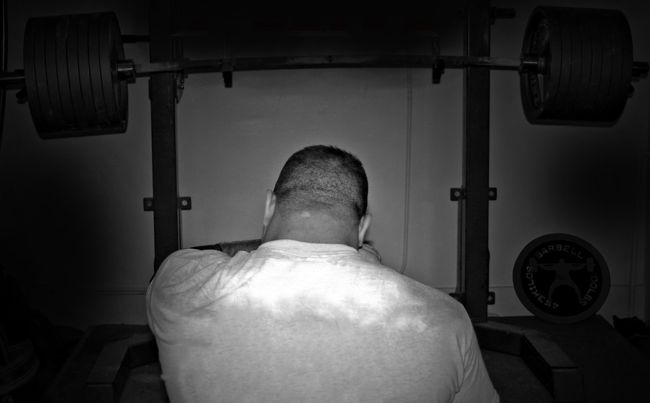
With a flexible measuring tape, my neck is 19.5 inches cold. (No, under my second chin.) I guess for a 5'8" man, that's fairly large.
I never really thought about it until a few years ago when I read about the Yoke on EFS. Why? I've always had a big neck. After some thinking, I began to figure out why.
1.) I did a ton of headbanging for decades. I would thrash until it hurt. I'm not sure how smart this was, but it worked wonders for my girth. If you want to follow this route, start here:
Along with that, I moved furniture for quite a few years and would “sneak” in some neck work.
Observe: Neck can be worked virtually anywhere with no equipment. Even just resisting with your hands on the back of your head while waiting for the elevator will do wonders over time.
2.) I have always paid attention to training the trapezius muscles — especially with heavy shrugs, power cleans, and indirectly, deadlifting. Tell me, have you ever seen a lifter with huge traps and a small neck?
Right now, in your seat, flex your traps. You can feel the muscle origins in the back of your head. Many people mistakenly think that area is part of the neck. It's not. It's actually part of the trapezius. Working the traps from all angles will make this bigger, and thus, make that thing under your head huge.
3.) I trained the neck directly right from the start. For some reason, when I was in college, a lot of guys would skip certain body parts — legs, forearms, neck, etc. (This is before my strength training days when I trained muscles instead of movements.) That never made sense to me. Would a carpenter build a house with a weak roof or foundation? I don't think so. Ergo, with a towel and later a neck harness, I began doing the following:
a) Starting with my chin to my chest, I would raise my head up until it couldn't go back any farther.
b) To work the splenus, levator, and scalene (side) muscles, I would do the same thing. Put one ear as far down toward your shoulder as you can, and then flex the opposite side to bring your head back up. Do this with both sides.
c) Hitting the sternocleidomastoid (front) muscles is a little trickier. Lie face up on a flat bench and put something on your forehead — preferably a towel with a weight on top. Move through the fullest range of motion possible being careful not to jerk the head during any part of the movement.
4.) I trained everything around the neck with heavy compound exercises—especially squats, rows, chins, military press, and dead lifts. These all work the neck directly or indirectly via stabilizing it.
5) I ate. Then I ate some more. For a while, when I knew nothing about nutrition except “eat more protein,” I did exactly that. This ties hand-in-hand with point number four. It's rare to find skinny, weak men with big necks. But—look at any top lifter, and I can guarantee he's more bull than chicken.
6.) I got creative. When I was banging out 100+ reps with the above-mentioned front neck exercise with a 45 pound plate on my head, I realized I needed to do something different. Go until your neck gets tired, but make sure to use the appropriate band. No jerking at any time.
What happens when a lifter takes 240 pounds and makes the neck bear that weight? Some jacked, swollen muscles!
7.) I made neck training a priority. It wasn't something I threw in as an extra. I thought about it and put it in an appropriate place in my program. For example, if I was doing heavy shrugs, why work the neck the same day? I would work it during a bench session where it would only be worked indirectly otherwise.
In addition, like grip, abs, forearms, and calves, it is possible to work the neck daily or close to that. The neck recovers quickly — especially once it's been strengthened for a while. Don't be afraid to superset it with other exercises during training.
As you can see, neck training is not hard, but too many people skip it or don't know how to do it. Start with this:
1.) Get a Spud Inc. Neck Harness.
2.) Do the exercises as I described them above. Start with light weight—maybe a ten pound plate. Do sets of 20 to 30 reps. Fatigue the neck, but don't go to failure.
3.) A useful guide is to train your neck with the same periodization that you are training your assistance work. For example, if you're doing three sets this week and four next week with the accessory movements, do the same with your neck. That way, you take the thought out of programming it and still reap all of the benefits.
4.) Increase the weight as necessary. If you get 25 good reps with a ten pound plate, go up to fifteen pounds, then twenty, and so forth. Or, use the 2.5 “chips.” This is one instance when those things are extremely useful.
5) Get the right equipment. Along with the Spud Inc. Harness, I recommend the following:
Econo Yoke; they didn't name it “Yoke” for nothing!
6' Farmer's Walk Handles Pair; big Farmer's Walks mean big traps and a huge neck.
Elite Stone Trainer; my personal favorite piece of equipment. This will make your back, traps and neck grow! Grow! Grow!
Trap Bar; just watch the video on the page. See his traps and neck? You need this bar!
And, after you get it, flaunt it: EFS Bull Tank
Thanks for reading! Please visit my training log or submit comments via the Q&A if you have any questions or need some guidance.








